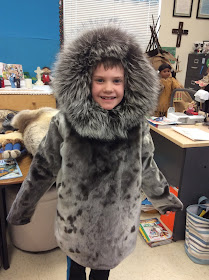We spent a lovely morning having a lady from the Strathcona Wilderness Centre
introduce us to artifacts, lifestyle, and interesting facts about the indigenous people living in the northern part of Canada. Our social studies curriculum ask the students to compare and contrast their own life with that of a child living on the East coast, in the Territories and on the prairies.
Our guide brought us many artifacts, and explained their use, how they were made and their importance in everyday life and survival.
We had the opportunity to see and touch the actual fur of many of the animals that are native to that part of our country.
No zippers or buttons...you have to slip right in..
this is a sealskin jacket with a fox collar.
We used our tallest boy to understand the size of a wolf...even with hands up, the wolf won!
Look at the size of the paw!
The students had an opportunity to work at four stations and this little guy tried on the fox tails and the kamiks, which are the waterproof footwear found in the eastern territories. No beads were used because that was not part of their trading practise.
One of the centres involved spinning tops. In the real life of the Inuit, the tops would have been bones.
Another centre was much like our game of tic tac toe, but again, the Inuit would not have had a cloth game card.
This group was very focused on using the rocks to try and create inukshuks.
Outside, the students tried out some of the games that are part of the Northern games, all involving strength and skill. They loved them all!
Thanks for sending the kiddos with warm clothing! It made them have more fun!
Over the last few weeks, we have been preparing for one of our math strategies for adding and subtracting larger numbers. Here we were recognizing where the numbers would be on a number line.
Notice that there are no numbers below. In the open number line, the students will choose to write the numbers and then make the 'jumps' based on their own number plans. In this example, the students were starting at a point, then recognizing the numbers it would take to get to the next ten. All of the students finished Grade One knowing which two numbers were 'friends' to make ten.
Expect to see an explanation sheet in this coming Friday's folder for the different strategies that we will explore. Only once the students understand the process of addition and subtraction we will introduce the algorithm that is typically taught in North American schools. It is fascinating to know that other countries don't all teach the same algorithm as we do. There are many ways to get to that mathematical solution!














No comments:
Post a Comment